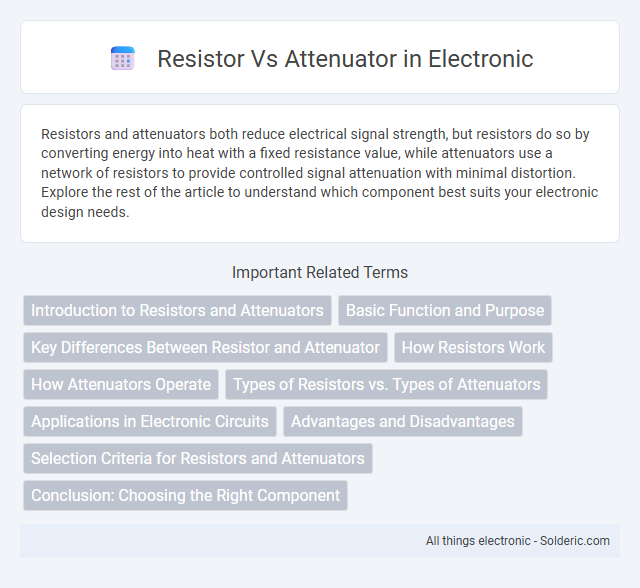Resistors and attenuators both reduce electrical signal strength, but resistors do so by converting energy into heat with a fixed resistance value, while attenuators use a network of resistors to provide controlled signal attenuation with minimal distortion. Explore the rest of the article to understand which component best suits your electronic design needs.
Comparison Table
| Feature | Resistor | Attenuator |
|---|---|---|
| Primary Function | Limits electric current and controls voltage | Reduces signal strength without significant distortion |
| Application | Voltage division, current limiting, biasing | Signal level adjustment in RF and audio circuits |
| Types | Fixed, variable (potentiometer) | Fixed, programmable, passive, active |
| Signal Impact | Causes voltage drop, power dissipation | Maintains impedance matching, controlled attenuation |
| Design Complexity | Simple component | Complex circuit involving multiple resistors or active elements |
| Use in RF Systems | Limited, mainly for biasing | Essential for signal power control and impedance matching |
| Power Handling | Varies by resistor rating (mW to Watts) | Designed for specific attenuation and power levels |
Introduction to Resistors and Attenuators
Resistors limit electrical current by providing a precise resistance value measured in ohms, essential for controlling voltage and current in circuits. Attenuators reduce signal strength without significantly distorting waveform quality, commonly used in RF and audio applications to manage signal levels. Understanding the function of each helps you select the right component for managing electrical signals effectively.
Basic Function and Purpose
Resistors control electrical current by providing a fixed resistance, enabling precise voltage division and current limiting in circuits. Attenuators reduce signal strength without significantly distorting waveform quality, commonly used in audio and RF applications to manage signal levels. Your choice depends on whether you need simple current control with a resistor or precise signal attenuation across a frequency range with an attenuator.
Key Differences Between Resistor and Attenuator
Resistors primarily limit current and drop voltage according to Ohm's Law, while attenuators are designed specifically to reduce signal strength uniformly across a range of frequencies. Resistors are simple, single-component devices, whereas attenuators often comprise multiple resistors arranged to maintain impedance matching and minimize signal distortion. Understanding these distinctions helps you select the right component for precise signal control and preservation in electronic circuits.
How Resistors Work
Resistors work by limiting the flow of electric current through a circuit by converting electrical energy into heat, following Ohm's Law which relates voltage, current, and resistance. In contrast, attenuators use resistors in specific configurations to reduce signal power without significantly distorting the waveform. Understanding how resistors regulate current helps you design effective circuits for controlling voltage and managing signal levels.
How Attenuators Operate
Attenuators operate by reducing signal power through controlled resistance, dissipating energy as heat to achieve precise signal attenuation levels without distortion. Unlike simple resistors that only limit current, attenuators use a combination of resistive elements arranged in specific configurations to maintain impedance matching and signal integrity. Your choice of an attenuator ensures stable signal reduction crucial for protecting sensitive equipment and optimizing system performance.
Types of Resistors vs. Types of Attenuators
Resistors come in various types such as carbon film, metal oxide, wire-wound, and surface-mount, each designed for specific applications based on power rating, tolerance, and frequency response. Attenuators are classified into fixed, variable, Pi-pad, T-pad, and ladder types, tailored to reduce signal strength precisely in radio frequency, audio, and communication systems. Your choice depends on whether you need simple resistance or controlled signal attenuation with impedance matching.
Applications in Electronic Circuits
Resistors serve as fundamental components in electronic circuits, regulating current flow, dividing voltage, and setting biasing conditions for transistors and amplifiers. Attenuators, often comprising networks of resistors, specialize in reducing signal amplitude without significantly distorting waveform shapes, making them essential for signal conditioning in RF and audio applications. Your choice between a resistor and an attenuator depends on whether you need simple current control or precise signal attenuation with impedance matching.
Advantages and Disadvantages
A resistor offers simplicity, low cost, and easy integration for basic current limiting but causes fixed voltage drops and power dissipation without precise signal control. An attenuator provides accurate signal level reduction with minimal distortion, enhancing measurement and audio applications, though it requires complex design and higher cost. Your choice depends on whether precision attenuation or basic resistance suffices for the task.
Selection Criteria for Resistors and Attenuators
Resistor selection focuses on power rating, tolerance, temperature coefficient, and frequency response to ensure stability and accuracy in circuits, particularly in signal conditioning and biasing applications. Attenuator choice prioritizes attenuation level, impedance matching, insertion loss, and linearity for precise signal reduction without distortion in RF and communication systems. Both components require careful consideration of operating frequency and environmental conditions to optimize performance and reliability.
Conclusion: Choosing the Right Component
Choosing the right component between a resistor and an attenuator depends on your specific application requirements, including signal integrity and precise attenuation levels. Resistors offer simplicity and cost-effectiveness for basic current limiting, while attenuators provide controlled signal reduction with minimal distortion. Your choice impacts overall circuit performance, making it essential to match the component type to your design's precision and stability needs.
resistor vs attenuator Infographic

 solderic.com
solderic.com